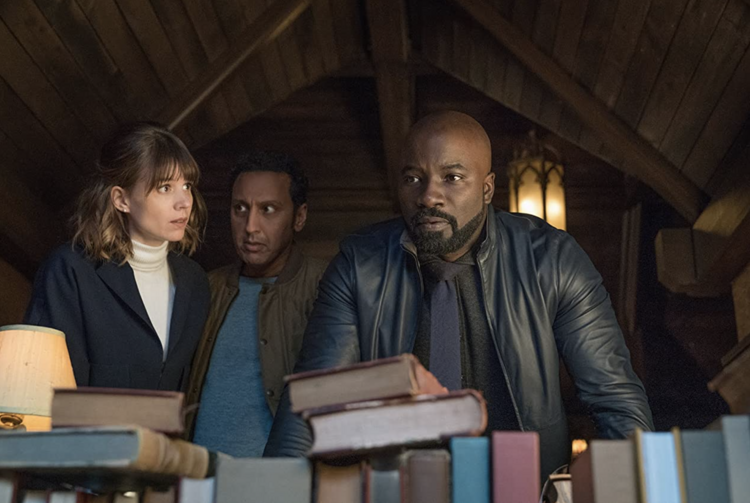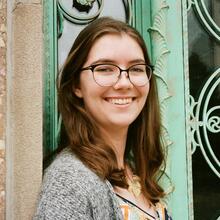A seminarian, an agnostic and an atheist walk into an exorcism. This isn’t a setup for a joke—it’s the premise of “Evil,” Paramount+’s Catholic horror series. The show stars Mike Colter, Katja Herbers and Aasif Mandvi as priest-to-be David, forensic psychologist Kristin and tech whiz Ben, brought together by a cardinal in New York to investigate reports of demons and miracles. Currently in production on its third season, the show is Paramount+’s hidden gem and the next Catholic horror hit fans of “Midnight Mass” have been waiting for.
Each of the three characters begins the series certain of their own convictions—David believing in God, Kristin in psychology and Ben in science and technology—only to be forced to question them in the face of the unbelievable or inexplicable. And in “Evil,” the unbelievable and inexplicable abound.
Rather than placing a Catholic patina on an essentially secular story, “Evil” is a deeply religious exploration of the unknown, in which every mystery has both religious and scientific explanations. It’s so effective because it plays on quintessentially Catholic fears and longings, the desire for miracles battling with the fear of the demonic. Questions of possession contend with those of mental illness, the mundane confronts the extraordinary, and the reality of doubt challenges lives of faith.
Rather than placing a Catholic patina on an essentially secular story, “Evil” is a deeply religious exploration of the unknown, in which every mystery has both religious and scientific explanations.
But most frequently of all, “Evil” leaves us in a gray area. The show seems to ask if we really want the truth, or if the answer will leave us too disturbed. Which would be worse: If evil and demons are real and immediately present in our lives? Or if there isn’t anything in life that can’t be explained?
“Evil” is not an easy show. It largely avoids jump scares and gratuitous gore, which helps make it watchable even for those who aren’t horror fans (myself included). But the second season asks difficult questions and gets progressively darker. The humor is darkly tongue-in-cheek, and sex, sin and temptation run throughout, as characters engage in transgressive pleasures from murder to drug use to adultery.
But as present as forces of evil are on the show, the Catholicism of “Evil” is also modern and very much alive. Though the show is Milton-esque with its web of demons and demonic sigils, it also wrestles with social injustice and new technology. Each episode explores a provocative intersection of the church and the world; a sampling of topics from the second season includes unions, racist policing, religious tax-exempt status and extraterrestrial life.
As present as forces of evil are on the show, the Catholicism of “Evil” is also modern and very much alive.
One episode deals with jinn, Islamic spirits that can be good or evil, leading to a combined exorcism conducted by both a priest and a sheikh. Another episode takes place in a cloister committed to absolute silence, where the team looks into reports of an incorruptible body, the characters exchanging significant glances and charades-style pantomimes to communicate. A third episode, “A for Angel,” will look particularly familiar to fans of “Midnight Mass” as the church investigates whether a monstrous, inhuman apparition is the avenging archangel Michael or a demon from Hell. (Just after the apparition promises a Revelations-style apocalypse to decimate humanity, a news alert on David’s computer warns of a plague found in Wuhan. Staring down the barrel of the third year of the pandemic, the effect is intensely skin-crawling.)
“Evil” shines a critical yet loving light on the church, unafraid to highlight the shortcomings of the institution—racism, political division, sexism, religious intolerance—while also not shying away from David’s powerful witness to his faith. When another Black man incredulously asks, “You believe in the Catholic Church?” David calmly responds, “And God. Jesus Christ, his son. Peter the rock. The Nicene Creed. The whole nine yards.” When the man accuses David of being a diversity token for the priesthood, David punches him in the face.
Like David, “Evil” doesn’t pull its punches. The episode “I for IRS” sharply critiques church involvement in politics, flashing a picture of a prominent cardinal standing next to Donald Trump. Other episodes show David struggling to speak freely about racism in the church while white priests try to redirect his homilies to something “less divisive.” The show directly addresses the fact that there are only 250 Black priests in the United States and the crisis this causes in David’s faith.
“Evil” shines a critical yet loving light on the church, unafraid to highlight the shortcomings of the institution while also not shying away from David’s powerful witness to his faith.
“Evil” also subtly centers the experience of women throughout; two episodes specifically highlight the work of nuns who care for orders of priests, doing often-invisible domestic work like cleaning their rooms, mopping their floors and washing their dishes. At one point David asks the spiritually powerful Sister Andrea why she isn’t on the exorcism team with the priests. Cleaning the floor on her hands and knees, she replies, “Because I’m a woman, and this is the Holy Catholic Church.”
But even with its sharp critiques, “Evil” never loses its Catholic center. Beyond its frequent exorcisms and sprinklings of holy water, its depiction of distraction in prayer—profanity drifting through David’s head as he tries harder and harder to focus, thereby only distracting himself further—is the best I have seen. And its scenes of confession are deeply powerful, driving home that the sacrament is about God’s grace and nothing else. Besides its mysteries and chills, the show asks real questions about the church and about ourselves.
“Evil” ultimately shows that the church is stronger for its openness to science and dialogue with nonbelievers, a refreshing take for a genre that can misappropriate religious symbols to try to conjure a false mysticism. For both its Catholic creeps and its thoughtful criticism of and engagement with the church, the show is a must-watch, particularly for fans of Catholic horror. But if you are looking for feel-good certainty, look elsewhere; in the fight between good and evil, the show seems to warn, evil might just win.







